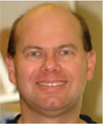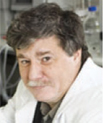Protein Linear Molecular Motor-Powered Nanodevices
David J. G. Bakewell A and Dan V. Nicolau A B CA Department of Electrical Engineering and Electronics, University of Liverpool, Brownlow Hill, Liverpool L69 3GJ, UK.
B Centre for Green Chemistry, Monash University, Clayton VIC 3800, Australia.
C Corresponding author. Email: D.Nicolau@liverpool.ac.uk

David Bakewell received a B.E.E. in electrical engineering (first-class honours) from the University of Melbourne in 1983 and a Ph.D. from the University of Glasgow in 2003 for his research on dielectrophoresis of colloids and polyelectrolytes. He joined the Australian Telecommunications Commission in 1984, and from 1985 to 1996 he conducted research into the performance of radio and optical fibre digital transmission systems and networks. From 2002 to 2005 David was with the Beatson Cancer Research Laboratories, Bearsden, UK, where he developed statistical methods for improving microarray gene expression estimation. He is currently with the Department of Electrical Engineering and Electronics, University of Liverpool. |

Professor Dan Nicolau holds the Chair in BioNanoEngineering in the Department of Electrical Engineering and Electronics at the University of Liverpool. He is also a Professorial Fellow at the Centre for Green Chemistry at Monash University, Melbourne, Australia. Dan is a Fellow of the International Society of Optical Engineering (SPIE), and has degrees in Chemical Engineering (Ph.D.), Cybernetics (M.Sc.), and Polymer Science and Engineering (M.Eng.). He has published 80 contributions in peer-reviewed scientific journals, a similar number of full papers in conference proceedings, and six book chapters. He has edited one book (with U. Muller; on microarray technology and applications), edited or co-edited the proceedings of 15 conferences (out of 20 that he has chaired since 2000), and was the Guest Editor of an issue of Biosensors & Bioelectronics. He is also an Editorial Board member of Journal of Bionanotechnology. |
Australian Journal of Chemistry 60(5) 314-332 https://doi.org/10.1071/CH06456
Submitted: 1 December 2006 Accepted: 8 February 2007 Published: 28 May 2007
Abstract
Myosin–actin and kinesin–microtubule linear protein motor systems and their application in hybrid nanodevices are reviewed. Research during the past several decades has provided a wealth of understanding about the fundamentals of protein motors that continues to be pursued. It has also laid the foundations for a new branch of investigation that considers the application of these motors as key functional elements in laboratory-on-a-chip and other micro/nanodevices. Current models of myosin and kinesin motors are introduced and the effects of motility assay parameters, including temperature, toxicity, and in particular, surface effects on motor protein operation, are discussed. These parameters set the boundaries for gliding and bead motility assays. The review describes recent developments in assay motility confinement and unidirectional control, using micro- and nano-fabricated structures, surface patterning, microfluidic flow, electromagnetic fields, and self-assembled actin filament/microtubule tracks. Current protein motor assays are primitive devices, and the developments in governing control can lead to promising applications such as sensing, nano-mechanical drivers, and biocomputation.
Acknowledgments
This paper is the result of many discussions with colleagues working in the molecular motors area. In particular, many of the ideas presented here have been sparked by hearty discussions with Hitoshi Suzuki and Kazu Oiwa at Kansai Advanced Research Center; Takahisa Taguchi and Noburu Yumoto at AIST in Japan; Rob Cross at Marie Curie Research Institute, UK; Cris dos Remedios at the University of Sydney, Australia; Gerry Pollack at Washington University; Henry Hess at University of Florida; and Fran Ligler at Naval Research Laboratories.
[1]
J. Howard,
A. J. Hudspeth,
R. D. Vale,
Nature 1989, 342, 154.
| Crossref | GoogleScholarGoogle Scholar |
| Crossref | GoogleScholarGoogle Scholar |
| Crossref | GoogleScholarGoogle Scholar |
| Crossref | GoogleScholarGoogle Scholar |
| Crossref | GoogleScholarGoogle Scholar |
| Crossref | GoogleScholarGoogle Scholar |
| Crossref | GoogleScholarGoogle Scholar |
| Crossref | GoogleScholarGoogle Scholar |
| Crossref | GoogleScholarGoogle Scholar |
| Crossref | GoogleScholarGoogle Scholar |
| Crossref | GoogleScholarGoogle Scholar |
| Crossref | GoogleScholarGoogle Scholar |
| Crossref | GoogleScholarGoogle Scholar |
| Crossref | GoogleScholarGoogle Scholar |
| Crossref | GoogleScholarGoogle Scholar |
| Crossref | GoogleScholarGoogle Scholar |
| Crossref | GoogleScholarGoogle Scholar |
| Crossref | GoogleScholarGoogle Scholar |
| Crossref | GoogleScholarGoogle Scholar |
| Crossref | GoogleScholarGoogle Scholar |
| Crossref | GoogleScholarGoogle Scholar |
| Crossref | GoogleScholarGoogle Scholar |
| Crossref | GoogleScholarGoogle Scholar |
| Crossref | GoogleScholarGoogle Scholar |
| Crossref | GoogleScholarGoogle Scholar |
| Crossref | GoogleScholarGoogle Scholar |
| Crossref | GoogleScholarGoogle Scholar |
| Crossref | GoogleScholarGoogle Scholar |
| Crossref | GoogleScholarGoogle Scholar |
| Crossref | GoogleScholarGoogle Scholar |
| Crossref | GoogleScholarGoogle Scholar |
| Crossref | GoogleScholarGoogle Scholar |
| Crossref | GoogleScholarGoogle Scholar |
| Crossref | GoogleScholarGoogle Scholar |
| Crossref | GoogleScholarGoogle Scholar |
| Crossref | GoogleScholarGoogle Scholar |
| Crossref | GoogleScholarGoogle Scholar |
| Crossref | GoogleScholarGoogle Scholar |
| Crossref | GoogleScholarGoogle Scholar |
| Crossref | GoogleScholarGoogle Scholar |
| Crossref | GoogleScholarGoogle Scholar |
| Crossref | GoogleScholarGoogle Scholar |
| Crossref | GoogleScholarGoogle Scholar |
| Crossref | GoogleScholarGoogle Scholar |
| Crossref | GoogleScholarGoogle Scholar |
| Crossref | GoogleScholarGoogle Scholar |
| Crossref | GoogleScholarGoogle Scholar |
| Crossref | GoogleScholarGoogle Scholar |
| Crossref | GoogleScholarGoogle Scholar |
| Crossref | GoogleScholarGoogle Scholar |
| Crossref | GoogleScholarGoogle Scholar |
| Crossref | GoogleScholarGoogle Scholar |
| Crossref | GoogleScholarGoogle Scholar |
| Crossref | GoogleScholarGoogle Scholar |
| Crossref | GoogleScholarGoogle Scholar |
| Crossref | GoogleScholarGoogle Scholar |
| Crossref | GoogleScholarGoogle Scholar |
| Crossref | GoogleScholarGoogle Scholar |
| Crossref | GoogleScholarGoogle Scholar |
| Crossref | GoogleScholarGoogle Scholar |
| Crossref | GoogleScholarGoogle Scholar |
| Crossref | GoogleScholarGoogle Scholar |
| Crossref | GoogleScholarGoogle Scholar |
| Crossref | GoogleScholarGoogle Scholar |
| Crossref | GoogleScholarGoogle Scholar |
| Crossref | GoogleScholarGoogle Scholar |
| Crossref | GoogleScholarGoogle Scholar |
| Crossref | GoogleScholarGoogle Scholar |
| Crossref | GoogleScholarGoogle Scholar |
| Crossref | GoogleScholarGoogle Scholar |
| Crossref | GoogleScholarGoogle Scholar |
| Crossref | GoogleScholarGoogle Scholar |
| Crossref | GoogleScholarGoogle Scholar |
| Crossref | GoogleScholarGoogle Scholar |
| Crossref | GoogleScholarGoogle Scholar |
| Crossref | GoogleScholarGoogle Scholar |
| Crossref | GoogleScholarGoogle Scholar |
| Crossref | GoogleScholarGoogle Scholar |
| Crossref | GoogleScholarGoogle Scholar |
| Crossref | GoogleScholarGoogle Scholar |
| Crossref | GoogleScholarGoogle Scholar |
| Crossref | GoogleScholarGoogle Scholar |
| Crossref | GoogleScholarGoogle Scholar |
| Crossref | GoogleScholarGoogle Scholar |
| Crossref | GoogleScholarGoogle Scholar |
| Crossref | GoogleScholarGoogle Scholar |
| Crossref | GoogleScholarGoogle Scholar |
| Crossref | GoogleScholarGoogle Scholar |
| Crossref | GoogleScholarGoogle Scholar |
| Crossref | GoogleScholarGoogle Scholar |
| Crossref | GoogleScholarGoogle Scholar |
| Crossref | GoogleScholarGoogle Scholar |
| Crossref | GoogleScholarGoogle Scholar |
| Crossref | GoogleScholarGoogle Scholar |
| Crossref | GoogleScholarGoogle Scholar |
| Crossref | GoogleScholarGoogle Scholar |
| Crossref | GoogleScholarGoogle Scholar |
| Crossref | GoogleScholarGoogle Scholar |
| Crossref | GoogleScholarGoogle Scholar |
| Crossref | GoogleScholarGoogle Scholar |
| Crossref | GoogleScholarGoogle Scholar |
| Crossref | GoogleScholarGoogle Scholar |
| Crossref | GoogleScholarGoogle Scholar |
| Crossref | GoogleScholarGoogle Scholar |
| Crossref | GoogleScholarGoogle Scholar |
| Crossref | GoogleScholarGoogle Scholar |
| Crossref | GoogleScholarGoogle Scholar |
| Crossref | GoogleScholarGoogle Scholar |
| Crossref | GoogleScholarGoogle Scholar |
| Crossref | GoogleScholarGoogle Scholar |
| Crossref | GoogleScholarGoogle Scholar |
| Crossref | GoogleScholarGoogle Scholar |
| Crossref | GoogleScholarGoogle Scholar |
| Crossref | GoogleScholarGoogle Scholar |
| Crossref | GoogleScholarGoogle Scholar |
| Crossref | GoogleScholarGoogle Scholar |
| Crossref | GoogleScholarGoogle Scholar |
| Crossref | GoogleScholarGoogle Scholar |
| Crossref | GoogleScholarGoogle Scholar |
| Crossref | GoogleScholarGoogle Scholar |
| Crossref | GoogleScholarGoogle Scholar |
| Crossref | GoogleScholarGoogle Scholar |
| Crossref | GoogleScholarGoogle Scholar |
| Crossref | GoogleScholarGoogle Scholar |
| Crossref | GoogleScholarGoogle Scholar |
| Crossref | GoogleScholarGoogle Scholar |
| Crossref | GoogleScholarGoogle Scholar |
| Crossref | GoogleScholarGoogle Scholar |
| Crossref | GoogleScholarGoogle Scholar |
| Crossref | GoogleScholarGoogle Scholar |
| Crossref | GoogleScholarGoogle Scholar |
| Crossref | GoogleScholarGoogle Scholar |
| Crossref | GoogleScholarGoogle Scholar |
| Crossref | GoogleScholarGoogle Scholar |

[166]


